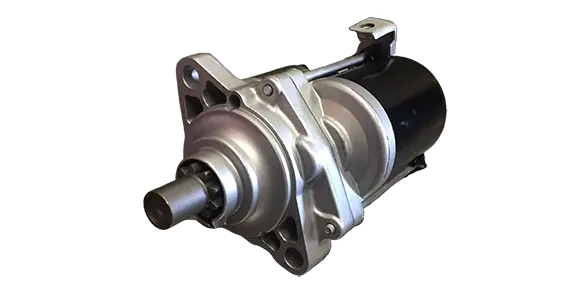STARTER
ABOUT USED STARTERS
WHAT IS A STARTER?
A starter is a device that initiates the starting up or ignition of the engine so it can operate on its own power. The starter is also known as the starter motor, self-starter, or cranking motor.
WHAT DOES THE PART DO?
The starter will rotate the combustion engine that allows it to begin operation. The starter typically sucks fuel and air into the cylinders and compresses it, enabling the engine’s operation to run under its own power. A starter is an important vehicle part, as it has the job of starting the engine and making the vehicle operational or drivable.
WHAT DOES THE PART LOOK LIKE?
A starter is a component that is shaped like a set of cylinders with the smaller cylinder set atop the larger cylinder. A starter is about six to eight inches in length and weighs about two to five pounds.
WHERE IS THERE PART TYPICALLY LOCATED ON THE VEHICLE?
The starter is usually located either in the steering column or right behind the dashboard of the driver's side of the vehicle.
WHAT DO YOU LOOK FOR IN A USED STARTER?
When looking at a used starter, you want to make sure that the casing is intact and that the part itself is free of any rust or corrosion. Also, you want to check the starter to see that the starter gear is in good shape. Finally, check to make sure that all the terminals are in proper order.
WHAT ELSE SHOULD I KNOW ABOUT A STARTER BEFORE I PURCHASE ONE?
When looking at used starters, you first need to know what kind of starter that you need. There are three types of starters available:
- Gear-reduction starter - These are the less common types of starters that have become more obsolete.
- Pneumatic starters - These starters are common in diesel powered vehicles and include a pressure tank, gas turbine, and air compressor.
- Electric starters - This is the most common starter used in most gas and diesel powered vehicles.
WHAT OTHER PARTS ARE CONNECTED OR THAT I MAY NEED FOR THIS PART?
The starter is connected to battery cables which are connected to the engine block.
WHAT TOOLS DO YOU NEED TO REMOVE A STARTER FROM A VEHICLE?
When removing or installing a starter into a vehicle, you will need the following:
- Socket and wrenches
- Screwdriver
- Pliers
- Battery terminal puller
- Drive-on ramps or a jack stand
WHAT SIGNS OF WEAR SHOULD I LOOK AT WHEN BUYING A USED STARTER?
If you notice corrosion on the battery terminals or that the gear looks worn down, then the starter may be at the end of its life. Also, be sure to check if there are any signs that there has been oil soaked inside the starter. That’s another sign that the starter is not able to properly do its job.
WHAT IS THE AVERAGE LIFESPAN OF A STARTER?
The average lifespan of a starter is about 100,000 to 150,000 miles.
WHEN SHOULD THE PART BE REPLACED?
A starter should be replaced if you observe the following behaviors in your vehicle:
- You hear a clicking noise when turning over the key
- The lights are on but there is no engine turn over
- The engine will not crank
- There is smoke coming from the car
- The strater is soaked in oil
FREQUENTLY ASKED QUESTIONS ABOUT STARTERS
WHAT ARE THE PARTS OF A STARTER?
Here are the most commonly found parts on a starter:
- Plunger
- Solenoid winding
- Solenoid contacts
- Field winding
- Field coil
- Shaft
- Yoke
- Pinion gear
- Drive lever
HOW MUCH CAN IT COST TO HAVE A STARTER INSTALLED?
The parts cost for a starter is going to cost anywhere from $310 to $410 while the labor cost will run anywhere from $110 to $140. Altogether the costs to have a starter installed is going to be between $420 to $550.
HOW LONG WILL A USED STARTER LAST?
A used starter’s lifespan will depend on the age of the part when it is installed in the vehicle. If the starter always have about 100,000 miles on it, then it should be good for another 50,000 miles.

